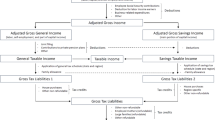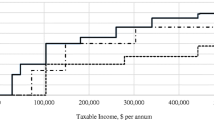Abstract
This paper estimates Spanish Personal Income Tax (IRPF) evasion by income sources, between 2005 and 2008, applying the methodology of Feldman and Slemrod (Econ J 117:327–352, 2007) to the IRPF Taxpayers Panel database published by the Instituto de Estudios Fiscales (Spanish Institute for Fiscal Studies). From the estimates carried out, four conclusions can be drawn. First, that the greatest tax compliance throughout the period is found in labour income and the lowest in income from movable capital. Second, that the level of compliance is, in general, lower in 2008 than in 2005. Third, that, with the exception of income from movable capital, compliance is greater for the top 50% of taxpayers. Fourth, that the lowest level of compliance is found in the group of regions with better structural economic characteristics: Aragon, Catalonia and Madrid.











Similar content being viewed by others
Notes
See Wiepking and Bekkers (2011, 2012). García and Marcuello (2001) use city size and Torregrosa (2015) city size and regional dummies to estimate the decision of donate by means of a Probit model and then calculate the inverse Mill ratio which is included in the model explaining the amount of charitable contributions according to Heckman model. We are not convinced of the explanatory capacity of these geographical variables, for the reasons given in the text.
Negative income is included, as in Feldman and Slemrod (2007), “to investigate whether the underreporting behaviour of positive and negative reported values of income conveys systematically different information about noncompliances” (p. 332): see Eq. (4) above. In Spain, negative income is generally admitted by the tax code, but is subject to certain rules of compensation with positive income. For the sake of simplicity, we include results for negative income in the Appendix, but not discuss them in the text. We also exclude capital gains because its results are distorted by the fact that capital gains are taxed upon realization instead of upon accrual and thus the income reported by the taxpayer in a fiscal year might be different from the income actually obtained in that year.
References
Allingham, M. G., & Sandmo, A. (1972). Income tax evasion: a theoretical analysis. Journal of Public Economics, 1(3–4), 323–338.
Alm, J. (2012). Measuring, explaining, and controlling tax evasion: lessons from theory, experiments, and field studies. International Tax and Public Finance, 19, 54–77.
Alm, J., & Borders, K. (2014). Estimating the “Tax Gap” at the State Level: the Case of Georgia’s Personal Income Tax. Public Budgeting and Finance, 34(4), 61–79.
Andreoni, J., & Payne, A. (2013). Charitable giving. In A. J. Auerbach, R. Chetty, M. Feldstein, & E. Saez, (Eds.), Handbook of Public Economics, vol. 5 (pp. 1–50). Amsterdam: North-Holland.
Bandrés, E., & Gadea, M. D. (2013). Crisis económica y ciclos regionales en España. Papeles de Economía Española, 138, 2–30.
Bittschi, B., Borgloh S., & Moessinger, M. D. (2016). On tax evasion, entrepreneurial generosity and fungible assets. Discussion paper 16-024, ZEW, Centre for European Economic Research.
Bloomquist, K.M. (2003). Tax evasion, income inequality and opportunity costs of compliance. Proceedings. Annual Conference on Taxation and Minutes of the Annual Meeting of the National Tax Association, 96: 91–104.
Consejo de Política Fiscal y Financiera (2010): Financiación de las comunidades autónomas por los impuestos cedidos, fondo de suficiencia y garantía de financiación de los servicios de asistencia sanitaria correspondiente al ejercicio 2008, Madrid. (http://www.minhap.gob.es/es-ES/AreasTematicas/FinanciacionAutonomica/Paginas/Informesfinanciacioncomunidadesautonomas2.aspx).
Domínguez-Barrero, F., López-Laborda J. & Rodrigo-Sauco, F. (2013). El hueco que deja el diablo: una estimación del fraude en el IRPF con microdatos tributarios, Documentos de Trabajo, 728, Madrid: FUNCAS; a shorter versión published in Revista de Economía Aplicada, 68, 2015: 81–102.
Feldman, N. E., & Slemrod, J. (2007). Estimating tax noncompliance with evidence from unaudited tax returns. Economic Journal, 117, 327–352.
Fiorio, C. V., & D’Amuri, F. (2005). Worker’s tax evasion in Italy. Giornale degli Economisti e Annali di Economia, 64(2/3), 247–270.
Freire-Serén, M. J., & Panadés, J. (2008). Does Tax evasion modify the redistributive effect of tax progressivity? The Economic Record, 84(267), 486–495.
García, I., & Marcuello, C. (2001). A household model of charitable contributions and tax incentives. Annals of Public and Cooperative Economics, 72(2), 159–181.
Johns, A., & Slemrod, J. (2010). The distribution of income tax noncompliance. National Tax Journal, 63(3), 397–418.
Lagares, M. J. (1990). La aceptación social del sistema tributario: el Impuesto sobre la Renta de las Personas Físicas. In E. Albi, dir., La hacienda pública en la democracia, pp. 109–132, Barcelona: Ariel.
Liu, X. (2014) Tax policy and entrepreneurship, Ph.D. diss., University of Tennessee. http://trace.tennessee.edu/utk_graddiss/2839.
López-Laborda, J., Vallés, J., & Zárate, A. (2014). IRPF dual y transformación de rentas generales en rentas del ahorro”, Estudios sobre la Economía Española, EEE2014-11. Madrid: FEDEA.
Matsaganis, M., Benedek, D., Flevotomou, M., Lelkes, O., Mantovani, D., & Nienadowska, S. (2010). Distributional implications of income tax evasion in Greece, Hungary and Italy, MPRA, Munich Personal RePEc Archive. http://mpra.ub.uni-muenchen.de/21465/1/MPRA_paper_21465.pdf.
Onrubia, J., Picos, F., & Pérez, C. (2011). Panel de declarantes del IRPF 1999-2007: Diseño, metodología y guía de utilización. Madrid: Instituto de Estudios Fiscales.
Onrubia, J., Picos, F., Pérez, C., & Gallego, M. C. (2012). Panel de declarantes del IRPF 1999-2008: Metodología, estructura y variables, Documentos, 12. Madrid: Instituto de Estudios Fiscales.
Pissarides, C. A., & Weber, G. (1989). An expenditure-based estimate of Britain’s black economy. Journal of Public Economics, 39(1), 17–32.
Torregrosa, S. (2015). Bypassing progressive taxation: Fraud and base erosion in the Spanish Income Tax (1970–2001), Documents de Treball de l’IEB 2015/31. Barcelona: Institut d’Economia de Barcelona.
Wiepking, P., & Bekkers, R. (2011). Who gives? A literature review of predictors of charitable giving. Part One: Religion, education, age and socialization. Voluntary Sector Review, 2(3), 337–365.
Wiepking, P., & Bekkers, R. (2012). Who gives? A literature review of predictors of charitable giving. Part Two: Gender, marital status, income, and wealth. Voluntary Sector Review, 3(2), 217–245.
Yitzhaki, S. (1974). A note on ‘income tax evasion: a theoretical analysis’. Journal of Public Economics, 3(2), 201–202.
Acknowledgements
We are indebted to José María Peláez, Eduardo Sanz Gadea, and two anonymous referees of the Journal for their helpful suggestions and comments. We also gratefully acknowledge the funding received from the Spanish Ministry of Economy and Competitiveness (project ECO2012-37572), the Regional Government of Aragon and the European Regional Development Fund (Public Economics Research Group). The usual disclaimer applies.
Author information
Authors and Affiliations
Corresponding author
Appendix
Appendix
See Table 2.
Rights and permissions
About this article
Cite this article
Domínguez-Barrero, F., López-Laborda, J. & Rodrigo-Sauco, F. Tax evasion in Spanish Personal Income Tax by income sources, 2005–2008: from the synthetic to the dual tax. Eur J Law Econ 44, 47–65 (2017). https://doi.org/10.1007/s10657-016-9553-0
Published:
Issue Date:
DOI: https://doi.org/10.1007/s10657-016-9553-0




